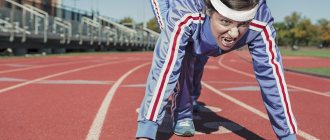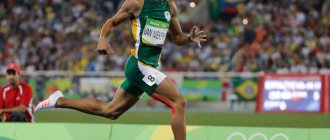- August 10, 2018
- Workouts in the gym
- Valery Savelyev
Three kilometers in the world of athletics is considered the average distance that an athlete must overcome. To show good results when running 3 km, an athlete must have good physical fitness both in terms of strength and endurance. The article discusses the issues of training athletes to run this distance, and also provides standards and world records for runners.
About history and Olympic records
The 3 km race has never been included in the men's competition program at the Olympic Games or the World Athletics Championships. In the case of women, this distance was included in their competition program at the Olympic Games from 1984 to 1996, then it was replaced by a 5 km run without obstacles.
For the first time among the Olympic disciplines, women began running 3 km at the 1984 Games in Los Angeles (USA). Then the Romanian Maricica Puica won, covering the distance in 8 minutes 35.96 seconds. Second place went to Britain's Windy Slee-Smith (8 minutes 39.47 seconds), and third place went to Canada's Lyn Williams (8 minutes 42.14 seconds).
World records
At the first World Championships, when this running distance was included in the competition program, the American Mary Decker-Slaney won, covering the distance in 8 minutes. 34.62 sec., second place was taken by the German Brigitte Kraus (8 min. 35.11 sec.), and third place belonged to the Soviet athlete Tatyana Kazankina (8 min. 35.13 sec.). This world championship was held in the capital of Finland, Helsinki, in 1983, that is, 1 year before 3 km appeared at the Olympic Games.
The very first record that women set when running this average distance belongs to the athlete from the USSR Lyudmila Bragina, who on August 12, 1972 in Moscow ran a distance of 3 km in 8 minutes 53.00 seconds.
Currently, the current record for this distance is the time shown by the Chinese athlete Wang Junxia; on September 13, 1993 in Pyongyang, she ran the distance in 8 minutes 6.11 seconds.
How long does it take men to run 3 km? It is interesting to note that although there has never been a serious world-class men's competition for this average running distance, there is still a world record. It belongs to Daniel Komen, an African runner from Kenya, who showed a time of 7 minutes 20.67 seconds.
Existing standards
Despite the fact that the 3 km distance is not included in the Olympic and world competition programs, standards for it still exist. As part of the training of the youth of our country, in order to receive the 3rd category, men need to overcome this distance in less than 10 minutes. 20 seconds, but if they run it faster than 8 minutes. 55 seconds, then they are awarded 1st category. For girls, the standards for running 3 km to obtain the indicated categories are 12 minutes. 30 sec. and 10 min. 30 sec. respectively.
It is interesting to note that the TRP standards differ significantly from the indicated figures. So, if a man is between 25 and 29 years old, then to earn a gold badge he needs to run 3 kilometers in just 12 minutes 30 seconds. Women do not run this distance, but pass the standards for covering 2 km.
conclusions
The key to a successful career in the ranks of the Russian Armed Forces is good physical fitness, which is achieved through hard work and training. To enter service on a contract basis, it is necessary to strictly invest in the standards, otherwise admission to the troops will be denied. Conscripts are accepted in any physical form, if health does not prevent this. During six months of service, they will significantly improve their physical performance, so in the second half of the term they must pass more stringent standards.
In order to easily settle into the ranks of the army, a conscript should take care of maintaining and improving his physical fitness some time before conscription, so that intense sports do not become a strong stress for the body.
How to improve your score on three rubles?
The result that an athlete shows when running 3 km depends on a number of factors. Of course, the key point is the athlete’s physical fitness, the level of which increases through correct and rational training programs. However, in addition to physical condition, there are other factors that you need to be aware of.
Firstly, the result on the three-ruble mark depends on how the athlete warms up. During its execution, he should warm up all the muscles well. Since running for three rubles is quite energy-intensive, it is necessary to put the muscles on “combat readiness” in order to increase the efficiency of their work during running, as well as reduce the risk of getting sprains.
Secondly, the physical and emotional state in which the athlete approaches the day of competition is of great importance. This factor is largely determined by planning a training program several days before the competition, taking into account the individual physical qualities of the athlete.
Finally, the result of a 3 km run is closely related to the tactics that the athlete chooses during the run itself.
Running tactics
When running at any distance, starting from 2-3 km or more, there are universal tactics that help to achieve maximum results, based on the physical condition of the athlete and his capabilities. This tactic can be expressed in the following formulation: you need to run the distance in such a way that the second half takes less time than the first.
The rule sounds quite simple and clear, but in reality it is difficult for any beginner and even an amateur to follow it. In order to put the correct running tactics into practice, you need to clearly know your strengths and be able to distribute them over the distance. Experts and trainers advise beginners to start jogging at a slow pace and increase their speed as the distance progresses. This is one of the effective methods to find out the capabilities of your body and learn how to correctly distribute forces on a three-ruble note.
Training program
To successfully meet the 3 km standard, you need to choose the right training program and strictly follow it. Experts recommend the following method of training if there are several months left before passing the standards or competitions: the entire period should be divided into 3 equal parts and left 1.5-2 weeks immediately before the race. These parts are also called training cycles.
In the first cycle, you need to gain basic running training. To do this, you should practice running slowly over a distance of 3 to 10 km. In addition, once a week you need to do strength training for your legs and upper body.
In the second cycle, it is necessary to include interval running in the training program. For example, divide a distance of 6 km into 6 equal segments and run each segment alternating between slow and fast paces.
In the third cycle of the training program, the athlete should add sprint running, that is, develop speed and speed by running distances of 100-200 meters.
When there are 1-2 weeks left before the final race for three rubles, it is recommended to significantly reduce the amount of physical activity in order to give the body sufficient time to rest and recover. For example, strength training and sprint running should be excluded completely, and interval running and distance running should be retained, but performed less frequently (2-3 times a week).
What clothes do they wear for training in the army?
In the army, everyone dresses the same for training; it’s unlikely to show off carbon sneakers or a fashionable cap. For each weather condition, the standards stipulate a certain set of clothing for a military personnel.
marathon and half marathon training plans and start training today!
Individual characteristics of thermoregulation are not taken into account here: if you are supposed to be wearing a hat, then you should have a hat on your head.
The table shows sports and military uniforms for the temperature range from +10℃ and above and -11℃ and below, in addition, there are clarifications for windy weather.
| temperature (°C) | Dress | |
| in calm weather with little wind | with wind more than 5 m/s | |
| Above +10 +5 to +10 +5 to -5 -5 to -10 From – 11 and below | No. 1 (C, B) or 2 (C, B) No. 2 (C, B) No. 3 (C, B) No. 4 (C, B) with gloves No. 5 (B) with gloves | No. 2 (C, B) No. 2 (C, B) or 3 (C, B) No. 3 (C, B) or 4 (C, B) No. 4 (C, B) with gloves No. 5 (B) (in strong winds - a hat with the earmuffs pulled down and tied with braid) |
The mark “C” means sports uniform, and “B” means military uniform. Depending on the air temperature, there may be several options for sports uniforms:
- Form No. 1C - in swimming trunks, shorts, a T-shirt, sports shoes. By decision of the commander (chief) of a military unit (military educational institution), under appropriate conditions, it is allowed to practice without a T-shirt and shoes.
- Form No. 2C - shorts, T-shirt, sports shoes.
- Form No. 3C - in a sports (training) suit, sports shoes.
- Form No. 4C - in an insulated sports (training) suit, insulated sports shoes, a sports hat.
Special types of running
In addition to the 3K training program described above, there are some specific types of running that can help you achieve better results in the middle distance. First of all, this is running with calf raises for short distances, as well as running uphill and downhill. These types of running develop leg muscles and train the body in anaerobic mode.
Like that:
| More running | More strength | I support | |
| Monday | Run | Power | |
| Tuesday | Run | Power | Strength, Running |
| Wednesday | |||
| Thursday | Run | Power | Strength, Running |
| Friday | Run | Power | |
| Saturday | Power | ||
| Sunday | Power | Run | Strength, Running |
General training of the athlete
Since 3 km running is a medium distance run, to achieve good results in it it is necessary to train not only endurance and running skills, but also muscles. Mainly these are the muscles of the lower body and the abs. The best exercises for training your legs are all kinds of jumping variations, such as jumping rope, hip raise, single leg, etc., as well as squats. It is also recommended to combine these exercises within one approach to their implementation.
Abdominal exercises can be performed both in the form of traditional lifting of the torso from a lying position, and lifting the legs from this position.
It must be remembered that 1.5-2 weeks before the start of the race, it is recommended to exclude all general physical activity from training.
What is the difference between PHYS standards in running for contract soldiers and conscripts?
Military personnel serving under contract have a greater age range than conscript soldiers. In addition, not only men, but also women can serve under a contract, and the requirements for women's sports standards differ from men's.
Men undergoing military service under contract are divided into eight age groups by standards: from the youngest “up to 25 years old” to the most experienced “55 years and older.” There are six age groups for women, the last of which is “45 years and older.” Each age group has its own standards for performing physical exercises.
Unlike contract soldiers, there are only two categories in conscript service. The first includes military personnel who have served for less than six months, and the second includes those who have already crossed this line. This is due to the fact that there are fewer requirements for recruits and the standards for them are a little simpler.
After six months of service, employees are expected to become stronger and improve their performance, which is why the standards become more complex.










